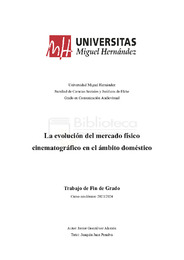Please use this identifier to cite or link to this item:
https://hdl.handle.net/11000/33302Full metadata record
| DC Field | Value | Language |
|---|---|---|
| dc.contributor.advisor | JUAN-PENALVA, Joaquín | - |
| dc.contributor.author | Gonzálvez Alarcón, Javier | - |
| dc.contributor.other | Departamentos de la UMH::Ciencias Sociales y Humanas | es_ES |
| dc.date.accessioned | 2024-09-26T08:47:02Z | - |
| dc.date.available | 2024-09-26T08:47:02Z | - |
| dc.date.created | 2024-06 | - |
| dc.identifier.uri | https://hdl.handle.net/11000/33302 | - |
| dc.description.abstract | Desde la creación del primer videocasete, el VCR de Philips, hasta los más recientes reproductores domésticos de vídeo, como los 4K Blu-ray, pasando por los populares VHS y DVDs, han transcurrido más de 50 años. Este trabajo se centra en la evolución del formato físico en la industria audiovisual, ofreciendo un recorrido desde sus inicios hasta la actualidad, y explorando cómo han evolucionado los distintos formatos, así como el cambio en las tendencias de consumo en los últimos años. En este estudio se abordarán los aspectos clave del proyecto, desde la democratización de los reproductores de vídeo en todos los hogares hasta su casi desaparición en favor del vídeo bajo demanda de las plataformas de streaming. Se hará hincapié en las ventajas e inconvenientes de cada formato y se presentarán los resultados de una encuesta realizada a 150 coleccionistas de películas en formato físico. Por último, se planteará qué podemos esperar en el futuro cercano para este mercado. | es_ES |
| dc.description.abstract | From the creation of the first video cassette, the Philips VCR, to the latest home video players, such as 4K Blu-ray, including the popular VHS and DVDs, over 50 years have passed. The focus of this work is the evolution of physical media in the audiovisual industry, providing a comprehensive overview from its beginnings to the present day, exploring how different formats have evolved and the shift in consumption trends in recent years. This study will cover the key aspects of the project, from the democratization of video players in every household to their near disappearance in favor of video on demand from streaming platforms. Emphasis will be placed on the advantages and disadvantages of each format, and the results of a survey conducted with 150 physical media movie collectors will be presented. Finally, we will discuss what we can expect in the near future for this market. | es_ES |
| dc.format | application/pdf | es_ES |
| dc.format.extent | 33 | es_ES |
| dc.language.iso | spa | es_ES |
| dc.publisher | Universidad Miguel Hernández de Elche | es_ES |
| dc.rights | info:eu-repo/semantics/openAccess | es_ES |
| dc.rights | Attribution-NonCommercial-NoDerivatives 4.0 Internacional | * |
| dc.rights.uri | http://creativecommons.org/licenses/by-nc-nd/4.0/ | * |
| dc.subject | formato físico audiovisual | es_ES |
| dc.subject | ventas | es_ES |
| dc.subject | evolución | es_ES |
| dc.subject | Blu-ray | es_ES |
| dc.subject | DVD | es_ES |
| dc.subject | VHS | es_ES |
| dc.subject | audiovisual physical media | es_ES |
| dc.subject | sales | es_ES |
| dc.subject | evolution | es_ES |
| dc.subject.other | CDU::7 - Bellas artes::77 - Fotografía. Cinematografía | es_ES |
| dc.title | La evolución del mercado físico cinematográfico en el ámbito doméstico | es_ES |
| dc.type | info:eu-repo/semantics/bachelorThesis | es_ES |

View/Open:
Gonzálvez Alarcón, Javier TFG.pdf
1,61 MB
Adobe PDF
Share:
.png)
